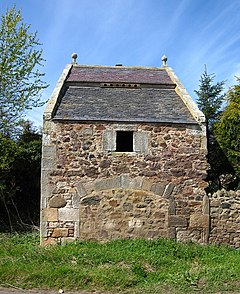East Fortune
| East Fortune | |
|---|---|
 East Fortune House Doocot |
|
| East Fortune shown within East Lothian | |
| OS grid reference | NT546792 |
| Civil parish | |
| Council area | |
| Lieutenancy area | |
| Country | Scotland |
| Sovereign state | United Kingdom |
| Post town | NORTH BERWICK |
| Postcode district | EH39 |
| Dialling code | 01620 |
| Police | Scottish |
| Fire | Scottish |
| Ambulance | Scottish |
| EU Parliament | Scotland |
| UK Parliament | |
| Scottish Parliament | |
East Fortune is a village in East Lothian, Scotland, located 2 miles (3 km) north west of East Linton. The area is known for its airfield which was constructed in 1915 to help protect Britain from attack by German Zeppelin airships during the First World War. The RNAS airship station also included an airship hangar. In 1919 the British airship R34 made the first airship crossing of the Atlantic, flying from East Fortune to Mineola, New York.
In 1922 several buildings and an area of land were used to create East Fortune Hospital. This served as a tuberculosis sanatorium for the south east region of Scotland until the onset of World War II. The airfield was then brought back into service as RAF East Fortune, initially a training airfield, and the hospital patients were transferred to Bangour Hospital in West Lothian. The hospital re-opened after the war, but by 1956, as the number of tuberculosis patients began to fall, the hospital changed its function to house the mentally handicapped. In 1997, the hospital closed down, and its patients were transferred to Roodlands Hospital in Haddington.
For a short period in 1961, East Fortune operated as Edinburgh's airport while facilities at Turnhouse were being reconstructed.
In 1975, the National Museum of Flight was opened at the airfield, and has since become a popular tourist attraction. It is also home to a Concorde, G-BOAA from the decommissioned British Airways fleet, which forms the centrepiece of a major exhibition about the Concorde programme.
...
Wikipedia

